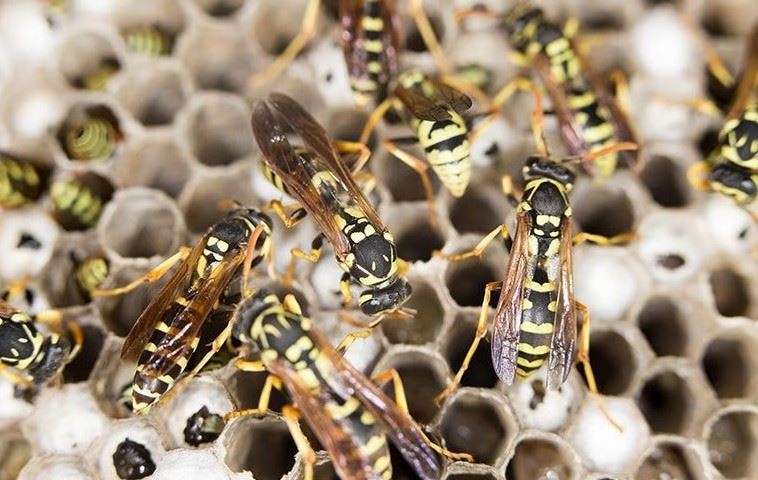
Stinging Insect Identification & Prevention
What are stinging insects?
Flying insects that sting are simply called "stinging insects." There are many different types of stinging insects around today, and it's important to avoid all of these species if you want to ensure that you stay safe from painful stings and widespread infestations on your property.
Most stinging insects can have either a yellow and black striped pattern or are dark with sometimes white markings. They have strong wings and a stinger at the end of their abdomen that they use to defend their nests or to hunt their prey.
Stinging insect nests tend to be hive-shaped, but they may also be located in holes in the ground or built alongside the siding of homes and businesses.

Are stinging insects dangerous?
Stinging insects are dangerous pests to have buzzing around your property, thanks to the trouble that their stings bring. Not only are these stings painful, but they may also trigger allergic reactions even in those without preexisting issues due to their insect-swarming behavior. Stinging insects are also aggressive and will sting any perceived threat, even if you accidentally pass by an area where they happen to be nesting.
Stinging insect control is vital to avoid these dangers.
Why do I have a stinging insect problem?
Stinging insects are generally attracted to properties with plenty of sweet-smelling flowers to feed off of and a bunch of areas to nest in. They also love properties with excess moisture. Evaluate your property for factors that attract stinging insects and take steps to remove them in order to deter these pests.
Where will I find stinging insects?
Stinging insects are typically found in their nests high up in trees, under the eaves of porches and decks, in holes in the ground, or along the siding of human structures. Stinging insect identification may be necessary to narrow down all the nest locations on your property.
How do I get rid of stinging insects?
Get rid of the worst stinging insects on your property by contacting Mike's Pest and Termite Control for home pest control help. Our team will help you identify stinging insect problem areas around your indoor and outdoor spaces and provide you with safe and reliable solutions to help eliminate all traces of these pests. With our help, you won't need to put yourself at risk combatting stinging insects or invest in less-than-effective DIY stinging insect control products.
How can I prevent stinging insects in the future?
Prevent problems with stinging insects in the future by following our expert tips below:
- Replace sweet-smelling flowers around your yard with plants that stinging insects hate, such as marigolds, basil, and cucumber.
- Always clean up food and drink spills outside and inside, as their aroma will attract stinging insects.
- Make sure to cover outdoor trash cans and compost piles so that stinging insects cannot scavenge in these areas.
- Fix leaks or other moisture issues that might contribute to pools of water around your property that attract pests.
- Fill holes in the ground, remove debris and brush from outdoor areas, and cut back any overgrown foliage that may encourage stinging insects to nest.
- Utilize window and door screens around your property to ensure stinging insects stay outside.
Contact Mike's Pest and Termite Control for more information on preventing troublesome stinging insects or for reliable assistance defeating an infestation of this pest.

Happy Customers in Your Neighborhood
Our Five Star Reviews
-
“The customer service received from everyone in this company was incredibly high. The communication and punctuality was fantastic.”- Judy S.
-
“Mike and his team alleviated a lot of stress. Very professional and friendly, timely service. If you are in need, do not hesitate.”- Karen K.
-
“Incredibly quick service with reasonable prices. Would recommend them to anyone!”- Megan M.
-
“We were so impressed with the team that we intend to switch to them for pest control as well. We highly recommend this company. They treat your home like it’s their home and that speaks volumes to us!”- Elina T.
Mike's Pest and Termite Control's Blog
Want all the latest news or updates? Browse through our blog to read our most recent posts and featured articles.

.2512020004464.jpg)





















